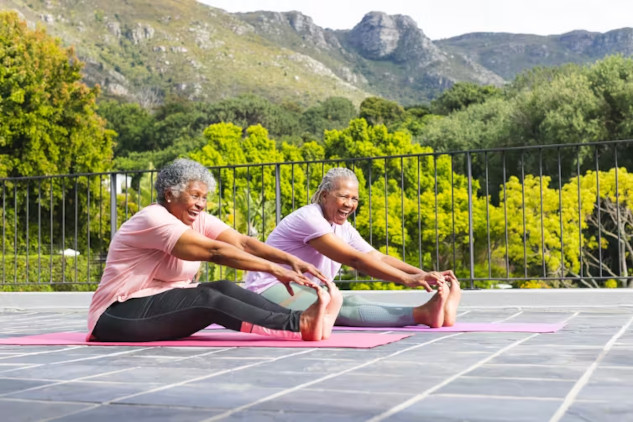In this Article:
- How does flexibility affect your overall health?
- What are the best stretching techniques to improve flexibility?
- How can flexibility prevent injuries and improve performance?
- Why is stretching important for balance and posture?
- What flexibility exercises can benefit you at different stages of life?
How To Improve Your Flexibility for Health and Injury Prevention
by Athalie Redwood-Brown and Jen Wilson, Nottingham Trent University.
Flexibility might not be the first thing that comes to mind when you think about health and fitness, but it’s one of the most important aspects of maintaining your body’s overall wellbeing.
Simply put, flexibility is all about how easily your muscles and joints can stretch and move. Even simple, everyday movements such as reaching up to grab something from a high shelf or bending down to tie your shoes require a certain level of flexibility.
Flexibility is crucial for keeping your body in top shape – playing a big role in your overall health and the way your body functions daily. Here are just some of the ways it is important – and tips for how to maintain your own flexibility:
1. Prevents injuries
One of the biggest benefits of being flexible is reducing your risk of injuries – including muscle strains and sprains.
Think about athletes who stretch regularly. It’s not just for show. Stretching keeps their muscles pliable and ready for action, which lowers the chances of getting hurt during a workout or competition.
Even if you’re not an athlete, staying flexible can help you avoid those dreaded injuries that can occur during daily life. Studies show that regular stretching can significantly reduce the risk of injuries, especially in older adults. Stretching makes muscle tendon units (where muscle meets the tendon) more flexible, which helps muscles resist over-stretching – leading to fewer injuries.
To reap the benefits of flexibility training and improve joint health, it’s recommended you regularly stretch three times a week – holding each stretch you do for 10-60 seconds.
2. Better balance and posture
Noticed how sitting at a desk all day can leave you feeling stiff and hunched over? Flexibility exercises can help with that. Stretching keeps your muscles long and loose, helping you maintain better posture and balance in the long run.
This is especially important as we get older, since poor posture can lead to falls and other injuries. Research suggests that flexibility training can improve alignment and posture, reducing the likelihood of falls and helping you move with more confidence.
3. Enhanced performance
Whether you’re playing a sport, going for a run, or just trying to keep up with your kids, flexibility can make a big difference in how you perform.
Flexible muscles allow for a greater range of motion, which makes it easier to perform movements that require strength, speed and agility. Research shows the reason stretching improves athletic performance is because it increases muscle efficiency and reduces risk of overuse injuries.
4. Reduced muscle tension and pain
In today’s world, many of us spend too much time sitting, which can lead to tight muscles and chronic pain – particularly in the back and neck . Flexibility exercises, such as stretching or yoga, can help alleviate this tension. These activities lengthen your muscles and improve blood flow, helping to relieve discomfort and prevent chronic pain from developing.
Studies have shown that stretching at least three times a week is effective in reducing muscle tension and easing pain – especially in areas prone to tightness, such as the lower back and shoulders.
5. Improved circulation
Good circulation is essential for overall health – and flexibility exercises can help improve this.
When you stretch, you increase blood flow to your muscles, which helps them recover faster and stay healthy. Improved circulation also benefits your heart and can help prevent long-term health conditions, such as cardiovascular disease.
Research indicates that regular flexibility exercises, particularly stretching, can boost your circulation and contribute to better cardiovascular health.
Improving flexibility at every age
To improve flexibility, you need to stretch.
There are a few different stretching techniques. The most recognisable is static stretching, where you hold a particular position for a brief period (usually 10-60 seconds).
Dynamic stretching, on the other hand, uses controlled movement or momentum to stretch muscles – and is typically performed a few times. The leg swing is a good example of a dynamic stretch. Yoga and Pilates are also forms of flexibility training that have a strength element.
Flexibility isn’t just for the young or athletic. It’s something everyone can benefit from – and can also be improved no matter your age.
Children and adolescents
Kids are naturally more flexible – but that doesn’t mean they shouldn’t work on their flexibility. Yoga, dance and active play can all help children and teens maintain and improve their flexibility. These activities aren’t only fun, they also promote overall physical development, coordination and balance.
Adults
As we get older, we need to be more intentional about staying flexible.
Try incorporating a stretching routine into your day. Even a quick morning stretch or yoga session can make a big difference. Yoga and Pilates are particularly effective because they combine flexibility with strength, helping you maintain your fitness overall.
Adults are recommended to stretch at least two-to-three times per week, holding each stretch for 10-60 seconds to stretch the major muscle groups. Ideally, this should happen when your muscles are warm to gain the most benefit.
Regular flexibility exercises will also help you maintain good joint health as you age.
Older adults
For older adults, flexibility is crucial for maintaining mobility and independence.
Gentle stretching exercises, such as chair yoga, are great options for improving flexibility without putting too much strain on the body. These exercises can also prevent stiffness, which is common as we age. Research also shows older adults who regularly stretch have a lower risk of falls and better quality of life. Older adults should also aim to stretch 2-3 times weekly.
So, whether you’re young or old, staying flexible is key to enjoying an active, pain-free life. Even just a few minutes of stretching each day can make a big difference.![]()
Athalie Redwood-Brown, Senior Lecturer in Performance Analysis of Sport, Nottingham Trent University and Jen Wilson, Senior Exercise and Health Practitioner, Nottingham Trent University.
Article Recap:
Flexibility is a crucial aspect of health, aiding in injury prevention, muscle tension relief, and better posture. Regular stretching exercises, such as static and dynamic stretches, help improve circulation, reduce muscle stiffness, and enhance overall body function. From kids to older adults, flexibility training is key to maintaining mobility and quality of life. Stretching at least 2-3 times a week, for 10-60 seconds per stretch, can greatly improve your flexibility and overall well-being.
This article is republished from The Conversation under a Creative Commons license. Read the original article.
Books on Fitness and Exercise from Amazon's Best Sellers list
The Four-Pack Revolution: How You Can Aim Lower, Cheat on Your Diet, and Still Lose Weight and Keep It Off
by Chael Sonnen and Ryan Parsons
The Four-Pack Revolution presents a total-life approach for attaining health and fitness goals without the hard work and suffering.
Click for more info or to order
Bigger Leaner Stronger: The Simple Science of Building the Ultimate Male Body
by Michael Matthews
If you want to build muscle, lose fat, and look great as quickly as possible without steroids, good genetics, or wasting ridiculous amounts of time in the gym and money on supplements, then you want to read this book.
Click for more info or to order
The Women's Health Big Book of Exercises: Four Weeks to a Leaner, Sexier, Healthier You!
by Adam Campbell
The Women's Health Big Book of Exercises is the essential workout guide for anyone who wants a better body. As the most comprehensive collection of exercises ever created, this book is a body-shaping power tool for both beginners and longtime fitness buffs alike.
Click for more info or to order
Bodyweight Strength Training Anatomy
by Bret Contreras
In Bodyweight Strength Training Anatomy, author and renowned trainer Bret Contreras has created the authoritative resource for increasing total-body strength without the need for free weights, fitness machines, or even a gym.
Click for more info or to order
The Men's Health Big Book of Exercises: Four Weeks to a Leaner, Stronger, More Muscular You!
by Adam Campbell
The Men's Health Big Book of Exercises is the essential workout guide for anyone who wants a better body. As the most comprehensive collection of exercises ever created, this book is a body-shaping power tool for both beginners and longtime fitness buffs alike.



























